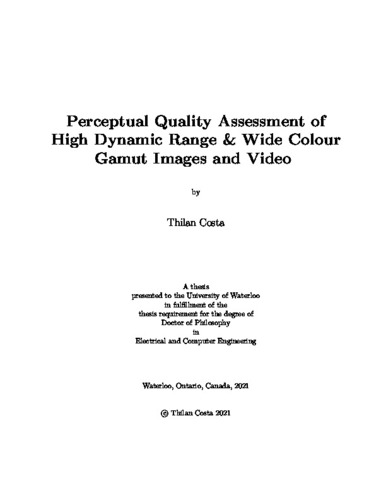| dc.contributor.author | Costa, Thilan | |
| dc.date.accessioned | 2021-06-15 16:58:44 (GMT) | |
| dc.date.available | 2023-06-16 04:50:04 (GMT) | |
| dc.date.issued | 2021-06-15 | |
| dc.date.submitted | 2021-06-11 | |
| dc.identifier.uri | http://hdl.handle.net/10012/17101 | |
| dc.description.abstract | While many successful algorithms have been proposed in the field of Image Quality Assessment (IQA) and Video Quality Assessment (VQA) through the years, High Dynamic Range (HDR) Wide Colour Gamut (WCG) technology and content have presented a unique set of challenges. Many IQA/VQA algorithms have ignored the colour in images and focused on performing quality assessment utilizing the luminance component of the image based on paradigms such structural similarity. However, HDR WCG technology emphasizes colour accuracy, creating a need for accurate assessment of colour quality in HDR content as well. In our work, we first study the performance of existing IQA/VQA methods in assessing the quality of HDR WCG content according to the existing IQA/VQA philosophy. We also check whether performance is affected by the use of constant luminance data as opposed to the commonly used non-constant luminance data in IQA/VQA applications. Then, we present the results of three colour difference measurement experiments performed using human subjects to study the performance of existing colour difference methods for HDR WCG content, as well as the effect of background luminance with respect to colour difference prediction. Our results show that existing methods are far from desirable in assessing colour difference in HDR WCG content. Therefore, we then utilize the data gathered from the colour difference tests to propose modifications to existing colour difference methods that significantly improve their performance for HDR WCG content. We then analyze the compatibility of the existing IQA/VQA philosophy with the requirements of IQA/VQA HDR WCG content. We demonstrate that the existing philosophy is inadequate in terms of the subjective testing methodology, as well as the operating paradigm of the IQA VQA algorithms. Finally, we propose a new IQA/VQA philosophy, and a new algorithm for HDR WCG IQA, followed by a UHD HDR WCG image database, subjective testing, and the performance results of the new proposed algorithm. The results indicate that the proposed algorithm performs successfully in HDR WCG IQA. | en |
| dc.language.iso | en | en |
| dc.publisher | University of Waterloo | en |
| dc.subject | High Dynamic Range | en |
| dc.subject | HDR | en |
| dc.subject | Wide Colour Gamut | en |
| dc.subject | Wide Colour Gamut | en |
| dc.subject | IQA | en |
| dc.subject | VQA | en |
| dc.subject | video quality assessment | en |
| dc.subject | image quality assessment | en |
| dc.subject | ICtCp | en |
| dc.subject | colour quality assessment | en |
| dc.subject | colour difference | en |
| dc.title | Perceptual Quality Assessment of High Dynamic Range & Wide Colour Gamut Images and Video | en |
| dc.type | Doctoral Thesis | en |
| dc.pending | false | |
| uws-etd.degree.department | Electrical and Computer Engineering | en |
| uws-etd.degree.discipline | Electrical and Computer Engineering | en |
| uws-etd.degree.grantor | University of Waterloo | en |
| uws-etd.degree | Doctor of Philosophy | en |
| uws-etd.embargo.terms | 2 years | en |
| uws.contributor.advisor | Gaudet, Vincent | |
| uws.contributor.advisor | R. Vrscay, Edward | |
| uws.contributor.affiliation1 | Faculty of Engineering | en |
| uws.published.city | Waterloo | en |
| uws.published.country | Canada | en |
| uws.published.province | Ontario | en |
| uws.typeOfResource | Text | en |
| uws.peerReviewStatus | Unreviewed | en |
| uws.scholarLevel | Graduate | en |

